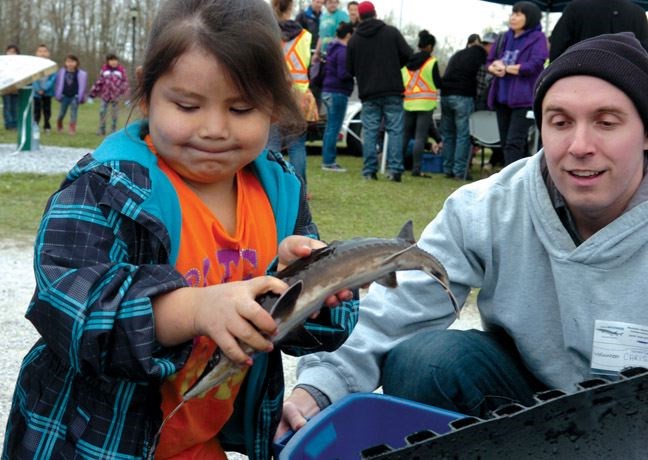Faces scrunched with the effort of holding slippery sturgeon, one-by-one elementary students helped release the endangered species into the Nechako River on Monday.
Now 1,250 white sturgeon have been added to the river stream, doubling the population, but still far below the 5,000 recorded in the 1950's. Virtually none of the long-lived species are younger than 45 thanks to an altered habitat that has been unable to support successful spawning.
With the help of 600 students, who gathered under the soft drizzle at Vanderhoof's Riverside Park to release the second half of this year's batch, sturgeon are just a little closer to survival.
That's what the Nechako White Sturgeon Recovery Initiative has been working toward since it launched in 2001.
"They realized there was a whole generation of fish missing," said Lana Ciarniello, its recovery coordinator. "Our ultimate goal is a self-sustaining population of sturgeon."
The project really came together in the last couple years, with an influx of $10 million in funding to build a hatchery last year in Vanderhoof and support ongoing research for the next 10 years. Before the 2013 announcement, it was starting to seem like saving the sturgeon wasn't possible.
"We believe we got there in time, but just in the nick of time," said Ciarniello.
A present-day dinosaur
Sturgeon can live to be more than 100 years old and can be traced back millions of years.
"They predate the dinosaurs," said Don Peterson, past president of the Freshwater Fisheries Society, also involved in the project.
"They've been here in this river since the retreat of the last ice sheet about 10,000 years ago and that's sustained the human communities that have lived here ever since, but it's only been in the last 50 or 60 years that we've started to impact them to the point where they could go extinct."
"In some ways they're like the old growth forest, the ancient trees."
It takes sturgeon 30 to 40 years before they can reproduce, said Cory Williamson, manager of the Nechako White Sturgeon Conservation Centre, making intervention now essential.
"There's a handful, maybe 20, 30, 50 that are going to spawn (in the Nechako River)," said Williamson, adding that won't change for decades until the juvenile fish released Monday - and over the next 10 years - mature.
Females spawn every three to five years and males skip a year.
"White sturgeon are the largest freshwater fish on the planet," said Williamson.
"Sturgeon worldwide are the most endangered group of vertebrates, so those are things with backbones, everything from lions and pandas," said Williamson, adding the vast majority of the 27 types are classified as critically endangered.
"They're about as bad off as you can get," he said.
The largest female found in the Nechako River was about 10 feet long and weighed in at more than 340 pounds.
That's on the small end of the scale, Williamson said, adding some sturgeon have been recorded at 1,800 lbs.
Sturgeon were traditionally used by First Nations both for food (though not a staple as it is a rich fish) and medicine.
"They're a dinosaur that's still alive today," said Christina Ciesielski fisheries program manager with the Carrier Sekani Tribal Council, which is partnering on the research. "Now it has a good chance of survival. It's amazing to see the community come together."
Saving the sturgeon
A number of factors have led to the white sturgeon's rapid decline, including the impact of the Kenney Dam, built in the mid-50s.
"What we're finding with our research is that the eggs are getting covered in silt and sand. The system used to flush before the Kenny Dam," Ciarniello said.
"Sturgeon eggs are very sticky. They lay their eggs and they drop to the bottom and they find an interstitial space - a space between the rocks - where they'll stick in there. What's happening is they're getting covered with silt and sand. Then they can't breathe, then they're dying."
Peterson said development along the watershed, including agriculture, forestry and urbanization have also had an impact.
"There's been changes in the watershed for a number of years since the dam, both the direct impact that had on the natural flows but also the indirect effects so the changes in sediment, movement in the river," said Peterson.
Ciarniello said part of the recovery research has involved clearing some of the riverbed and placing eggs on clean gravel.
That has produced encouraging results, she said, but "it takes years to see that return."
The hope is to restore spawning within a five year timeframe.
In the meantime, it's about giving the juvenile sturgeon released into the river the best chance at survival.
They planned to release 12,000 this year but experienced some first-year glitches, she said. The hatchery had water quality issues and high river temperatures during the critical first feed period.
But 12,000 remains the goal for next year - and each of the remaining nine years of the project.
Release size has been an important factor in the young sturgeon's survival chances, said Williamson.
The sturgeon released Monday were between 550 and 900 grams, which makes them less likely to fall as prey. Predators typically eat things that are 10 per cent of their size, so the larger sturgeon were skipping some of that risk.
"It' absolutely fantastic," said Peterson, who watched as kid after kid plopped the squirming fish down a chute leading to the river. Each was tagged with micro-chips so they can be tracked, and each was christened with names (like "Nemo") by the kids.
Williamson said the project couldn't have come together without the support of the community, and that getting children to take part in the release was a deliberate decision.
"This whole recovery process is intergenerational," he said. "I'm going to be retired before these fish are even ready to spawn and so introducing another generation to the value of having this really iconic species stay in the river is important."



